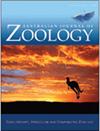对澳大利亚生态系统中本地物种和入侵物种之间的相互作用进行分类
IF 1
4区 生物学
Q3 ZOOLOGY
引用次数: 0
摘要
澳大利亚与野狗的存在隔绝了大约4000万年,直到野狗的引入(Canis familiaris;4000年前),狐狸(Vulpes Vulpes;1871)和野猫(Felis catus;post - 1788)。这些入侵物种的到来与许多本土哺乳动物的减少和灭绝同时发生,特别是在临界体重范围内(35-5500 g)。这些灭绝可能是竞争和捕食的结果,其中运动性能和相关行为在很大程度上有助于整体适应。我们利用外来掠食者存在时本地动物的种群反应来建立一个研究框架。引入/灭绝时间线、捕食者饮食和猎物发生用于确定入侵/本地关系,其中捕食可能决定种群结果。然后,我们使用当前数据(最大速度)检查了这些物种的运动性能。对猎物的消耗似乎与捕食者遇到猎物的概率无关。澳洲野狗是所有入侵掠食者中最多变的哺乳动物猎物,可能是因为它们的最大速度更高。野猫更喜欢野猫科和较小的物种,它们比野狗和狐狸更喜欢捕食这些猎物。运动表现在入侵生态中的作用尚不清楚;我们确定了需要进一步探索的关系。本文章由计算机程序翻译,如有差异,请以英文原文为准。
Classifying relationships that define interactions between native and invasive species in Australian ecosystems
ABSTRACT Australia was isolated for approximately 40 million years from the presence of eutherian predation until the introduction of the dingo (Canis familiaris; 4000 years ago), foxes (Vulpes vulpes; 1871) and feral cats (Felis catus; post-1788). The arrival of these invasive species coincides with the decline and extinction of many native mammals, specifically within the critical weight range (35–5500 g). These extinctions are likely a result of competition and predation, where locomotor performance and the associated behaviours contribute largely to overall fitness. We used the population responses of native fauna in the presence of introduced predators to establish a research framework. Introduction/extinction timelines, predator diets, and prey occurrence were used to identify invasive/native relationships where predation may define the population outcome. We then examined the locomotor performance of these species using current data (maximum speeds). Consumption of prey items does not seem to be associated with the probability of the predator encountering the prey. Dingoes had the most variable mammalian prey of all invasive predators, likely due to higher maximal speeds. Feral cats favour Dasyuridae and smaller species, preying upon these prey groups more than dingoes and foxes. The role of locomotor performance in invasive ecology is not well understood; we identified relationships for further exploration.
求助全文
通过发布文献求助,成功后即可免费获取论文全文。
去求助
来源期刊
CiteScore
2.40
自引率
0.00%
发文量
12
审稿时长
>12 weeks
期刊介绍:
Australian Journal of Zoology is an international journal publishing contributions on evolutionary, molecular and comparative zoology. The journal focuses on Australasian fauna but also includes high-quality research from any region that has broader practical or theoretical relevance or that demonstrates a conceptual advance to any aspect of zoology. Subject areas include, but are not limited to: anatomy, physiology, molecular biology, genetics, reproductive biology, developmental biology, parasitology, morphology, behaviour, ecology, zoogeography, systematics and evolution.
Australian Journal of Zoology is a valuable resource for professional zoologists, research scientists, resource managers, environmental consultants, students and amateurs interested in any aspect of the scientific study of animals.
Australian Journal of Zoology is published with the endorsement of the Commonwealth Scientific and Industrial Research Organisation (CSIRO) and the Australian Academy of Science.

 求助内容:
求助内容: 应助结果提醒方式:
应助结果提醒方式:


